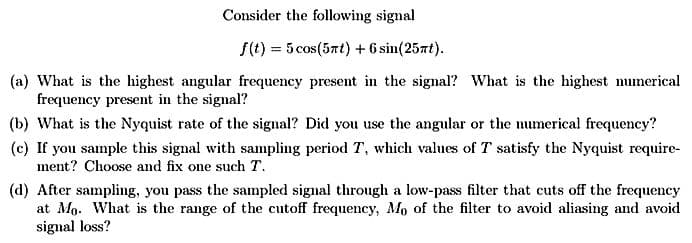Consider the following signal f(t) = 5 cos(5πt) + 6 sin(257t). (a) What is the highest angular frequency present in the signal? What is the highest numerical frequency present in the signal? (b) What is the Nyquist rate of the signal? Did you use the angular or the numerical frequency? (c) If you sample this signal with sampling period T, which values of T satisfy the Nyquist require- ment? Choose and fix one such T. (d) After sampling, you pass the sampled signal through a low-pass filter that cuts off the frequency at Mo. What is the range of the cutoff frequency, Mo of the filter to avoid aliasing and avoid signal loss?
Consider the following signal f(t) = 5 cos(5πt) + 6 sin(257t). (a) What is the highest angular frequency present in the signal? What is the highest numerical frequency present in the signal? (b) What is the Nyquist rate of the signal? Did you use the angular or the numerical frequency? (c) If you sample this signal with sampling period T, which values of T satisfy the Nyquist require- ment? Choose and fix one such T. (d) After sampling, you pass the sampled signal through a low-pass filter that cuts off the frequency at Mo. What is the range of the cutoff frequency, Mo of the filter to avoid aliasing and avoid signal loss?
Introductory Circuit Analysis (13th Edition)
13th Edition
ISBN:9780133923605
Author:Robert L. Boylestad
Publisher:Robert L. Boylestad
Chapter1: Introduction
Section: Chapter Questions
Problem 1P: Visit your local library (at school or home) and describe the extent to which it provides literature...
Related questions
Question
100%
UPVOTE WILL BE GIVEN. PELASE WRITE THE SOLUTIONS LEGIBLY. NO LONG EXPLANATION NEEDED. SOLVE IN 4 DECIMAL PLACES. BOX THE FINAL ANSWERS
ANSWER LETTER D ONLY.

Transcribed Image Text:Consider the following signal
f(t) = 5 cos(5πt) + 6 sin(257t).
(a) What is the highest angular frequency present in the signal? What is the highest numerical
frequency present in the signal?
(b) What is the Nyquist rate of the signal? Did you use the angular or the numerical frequency?
(c) If you sample this signal with sampling period T, which values of T satisfy the Nyquist require-
ment? Choose and fix one such T.
(d) After sampling, you pass the sampled signal through a low-pass filter that cuts off the frequency
at Mo. What is the range of the cutoff frequency, Mo of the filter to avoid aliasing and avoid
signal loss?
Expert Solution
This question has been solved!
Explore an expertly crafted, step-by-step solution for a thorough understanding of key concepts.
This is a popular solution!
Trending now
This is a popular solution!
Step by step
Solved in 3 steps with 3 images

Knowledge Booster
Learn more about
Need a deep-dive on the concept behind this application? Look no further. Learn more about this topic, electrical-engineering and related others by exploring similar questions and additional content below.Recommended textbooks for you

Introductory Circuit Analysis (13th Edition)
Electrical Engineering
ISBN:
9780133923605
Author:
Robert L. Boylestad
Publisher:
PEARSON

Delmar's Standard Textbook Of Electricity
Electrical Engineering
ISBN:
9781337900348
Author:
Stephen L. Herman
Publisher:
Cengage Learning

Programmable Logic Controllers
Electrical Engineering
ISBN:
9780073373843
Author:
Frank D. Petruzella
Publisher:
McGraw-Hill Education

Introductory Circuit Analysis (13th Edition)
Electrical Engineering
ISBN:
9780133923605
Author:
Robert L. Boylestad
Publisher:
PEARSON

Delmar's Standard Textbook Of Electricity
Electrical Engineering
ISBN:
9781337900348
Author:
Stephen L. Herman
Publisher:
Cengage Learning

Programmable Logic Controllers
Electrical Engineering
ISBN:
9780073373843
Author:
Frank D. Petruzella
Publisher:
McGraw-Hill Education

Fundamentals of Electric Circuits
Electrical Engineering
ISBN:
9780078028229
Author:
Charles K Alexander, Matthew Sadiku
Publisher:
McGraw-Hill Education

Electric Circuits. (11th Edition)
Electrical Engineering
ISBN:
9780134746968
Author:
James W. Nilsson, Susan Riedel
Publisher:
PEARSON

Engineering Electromagnetics
Electrical Engineering
ISBN:
9780078028151
Author:
Hayt, William H. (william Hart), Jr, BUCK, John A.
Publisher:
Mcgraw-hill Education,